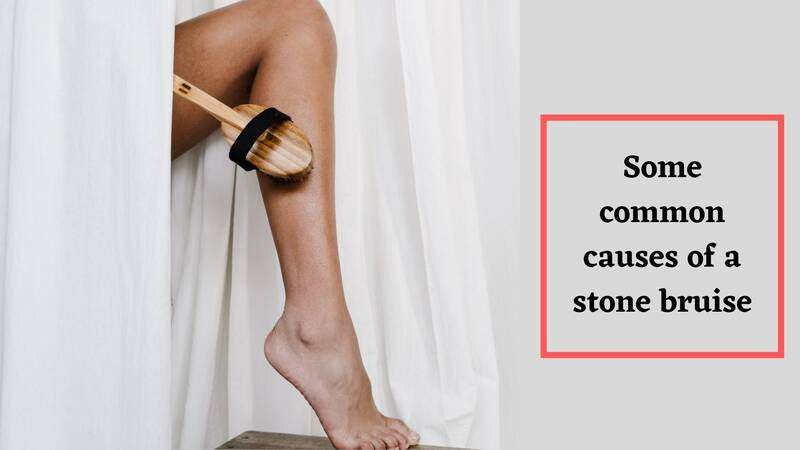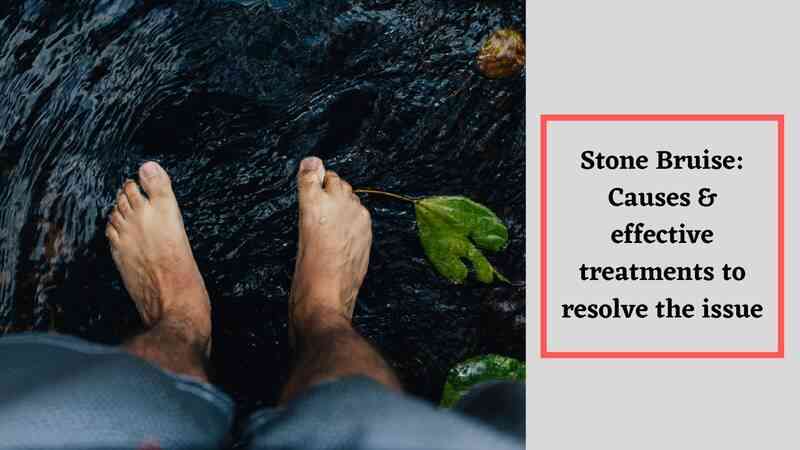You should come down hard on a few specific things, such as crime or even a kid’s refusal to consume vegetables.
It should cause you all discomfort when you are putting your foot down on anything.
Today, in our posts, we will look into the varied aspects of a stone bruise, including the probable causes and the treatments.
It is the kind of pain that you may feel at times known as “stone bruise,” as it is the general catchphrase of this term.
You may even hear the term “Metatarsalgia” that is thrown around which is a significant medical term for this type of pain in your forefoot.
But, let us not get hung up on any type of vocabulary as you would probably be calling it a huge pain somewhere at the ball of your foot and the fat pad present on your heel.
Contents
What do you understand by Stone bruise?
The stone bruise is the pain on the ball of your foot and the pad of your heel. It has two different derivations:
While you are stepping down harder on the smaller objects such as the pebbles and stones as it is painful, this pain would often last after your foot gets off the pain-causing object.
It may feel like you step on a smaller stone or a pebble when you are putting weight on the painful area on the bottom of your foot,
The term tends to be the non-medical catch over every name associated with the painful symptoms that feel like a stone in your shoe jabs at the bottom of your foot each time you take a step.
The commonest cause of the stone bruise is generally an impact injury at the bottom of your foot caused by stepping down harder on a smaller hard object such as a rock.
Some runners have several hard foot impacts while running as they are likely to occasionally find themselves with the stone bruise, mainly if they are running on the rocky terrain.
You may feel the pain instantly, or it may take about 24 to 48 hours for the bruises to materialize while your foot is making contact with an object.
We spend a lot of time on our feet; a bone bruise from this impact injury can hardly be persistent and can affect each step is what we take.
Several conditions produce symptoms that are mistaken for stone bruising during your self-diagnosis.
Read– Waking Up With Dry Mouth
Some common causes of a stone bruise

Below we share some common causes of Stone Bruises
Metatarsalgia
Metatarsalgia is generally the inflammation or the pain in the ball of your foot, and it is commonly considered an overuse of the injury.
It is generally characterized by the aching, burning, and sharp pain in the area of your foot located just behind your toes.
There is a pain that intensifies while you stand, walk, run, and even flex your foot.
The following are the main causes of metatarsalgia:
- the greater intensity of higher-impact activities, including jumping and running
- excessive body weight
- Badly fitting shoes
- deformities of the foot such as the hammer toe or bunions
The following are the treatments for Metatarsalgia:
- improper fitting shoes
- arch support or shock-absorbing
- insoles for the rest, elevation, and ice
- over-the-counter (OTC) pain medication, including aspirin, naproxen (Aleve) along with ibuprofen (Advil)
Plantar fasciitis
The band of tissue connecting your toes to your heel bone is the plantar fascia.
The condition is known as plantar fasciitis when the tissue becomes inflamed.
It is generally characterized by stabbing pain in the sole of your foot located near the heel.
The pain generated out of the plantar fasciitis is more intense after exercising.
The following is the treatment included for plantar fasciitis:
- Over-the-counter pain relievers such as naproxen (Aleve) or ibuprofen (Advil)
- stretching and physical therapy
- there is a splint to be worn while you are asleep
- orthotics, custom-fitted arch supports
- steroid injections
- surgery
Heel spur
A heel spur is the boniest protrusion or osteophyte that generally grows on the front of your heel bone, extending towards the arch of your foot.
Your doctor can suggest an OTC pain reliever to relieve the pain associated with a heel spur, such as acetaminophen or Tylenol.
There are several other treatments, including:
- physical therapy
- orthotics
- shoe recommendation
- night splint
- surgery
Stress fracture
Overuse, such as long-distance running, can create microscopic cracks in the bones of the foot, which are known as stress fractures.
Surgery for stress fractures in the feet is uncommon.
Treatment usually entails reducing the weight on the affected area until it heals.
This weight loss is frequently achieved through:
- crutches
- a brace
- a walking boot
Morton’s neuroma
Morton’s neuroma is a condition in which the tissue encloses the digital nerve that leads to your toe bones (metatarsals) thickens.
This usually happens between the third and fourth toes, affecting considerably more women than males.
You may have a searing ache in the sole if you have Morton’s neuroma.
You may also get soreness in your toes.
Researchers have described jogging or walking when wearing high heels or partaking, and the discomfort is usually more intense.
The following are the treatments included for Morton’s neuroma:
- change over to the different styles of shoes
- receiving the corticosteroid injections
- making use of orthotics
- receiving the steroid injections
Read– Benefits of Ice Bath
Risk Factors existing for a Stone Bruise
A few people are more likely to be suffering from a stone bruise than the rest or have their pain worsen or longer-lasting.
People who run have already been noted, but any exercise involving repetitive, hard blows to the foot, such as running or jumping, increases the risk of injury.
It is why we always emphasize adequate fitness and avoiding overuse in athletes; pushing you too hard and too fast will lead to pain and damage.
On the other hand, internal and intrinsic factors can enhance the chance of stone bruising.
A structural irregularity, such as flat feet or high arches, can change how weight and forces are distributed over each foot, resulting in greater pressure and the risk of injury in certain areas.
The following are the additional aspects included here:
Excess weight. A greater amount of pressure is exerted on your feet over every step.
Aging. The less of a protective fat pad there tends to be along the bottom of the foot as you age.
Poor footwear. It will range from athletic shoes whose supportive properties have worn out to higher heels forcing excessive pressure toward the front side of your foot.
Medical conditions. There are deformities on your toe, including degenerative conditions and bunions, including diabetes or rheumatoid arthritis affecting the structure of your foot in several ways, making it more prone to stone bruises and other injuries.
Read– Facial Feminization Surgery Cost
How to treat the Stone Bruises?

A stone bruise is usually treated efficiently with RICE (rest, ice, compression, and elevation). Within a week, the swelling and soreness should have subsided.
However, if the discomfort persists or does not improve, it is time to contact your doctor or health care provider.
It’s possible that a stone bruise is not a stone bruise but rather a stress fracture along the bone.
Another ailment will necessitate rest, but it may also necessitate a different approach.
Furthermore, recurring stone bruises or other types of foot and heel pain indicate that something must be altered or addressed.
Several methods are included in the treatment involving the change in the workout routines or footwear.
Suppose there are any structural issues in your feet.
In that case, custom orthotics are recommended to offer the exact cushioning support required, thereby reducing the excessive amount of stress to where it should not be.
Please, you should not hesitate to contact your professionals if you have a particularly painful or severe situation that inhibits daily mobility.
Read– Mustard For Cramps
FAQs
Below we share some FAQs related to the Quarry of Stone Bruise
1〉 How long does it take for a stone bruise to heal on your foot?
The tenderness will fade as the wound heals, and the blood will be digested.
As a result, bruised skin changes color from red to bluish to yellowish, then back to normal.
A bruise usually takes two weeks to heal completely.
2〉 How long does a heel stone bruise take to heal?
It can also result from a single accident, such as landing on your heel after jumping from a great height.
In either case, the bruise can hurt when you take a step. It can take one to three weeks for a bruised heel to recover, and it could take up to six weeks to recover if you’ve additionally bruised your heel bone.
3〉 How bruising on the foot happens without an injury?
The unexplained or easy bruising on the feet is caused by age, lifestyle, and gender factors, including aging skin.
There is alcohol abuse, including among the female gender.
4〉 How can we fix a stone bruise?
The basic RICE method effectively treats a stone bruise, which means rest, ice, compression, and elevation.
The pain and swelling are expected to improve in just a week. It is time to call your doctor if the pain does not improve or continues to happen.
5〉 Is a bruising on my foot something to be concerned about?
Bruises are commonly applied injuries that heal independently without the need for medical intervention, and they can be safely treated at home.
However, if you have discoloration that does not heal or fade two weeks after a more serious accident or injury, you should seek medical help.
6〉 Is it possible for a stone bruise to turn into an abscess?
Bloodstains or streaks may appear in the bruised region. A severe bruise may develop into an abscess, necessitating treatment such as emptying the abscess and bathing the foot.
After an abscess is drained and treated, it normally clears up quickly, but the cavity in the sole may take many months to refill with a new horn.
7〉 Why does it feel like you have a stone in your feet?
The bunched-up sock or the feeling of a pebble can be an effective symptom of Morton’s neuroma.
The condition is defined by thickening and swelling of the tissues surrounding one of the nerves leading to your toe.
The common site for the neuroma in the foot lies between the third and fourth buddy.
8〉 What would be Diabetic Foot, and How Does It Affect You?
Diabetes patients frequently experience foot difficulties. When high blood sugar destroys the nerve cells in the feet, they might develop over time.
Diabetic neuropathy is nerve degeneration that can bring numbness, trembling, pain, or lack of feeling in your feet.
9〉 How does leukemia bruising appear?
You may notice “rashes” on your skin in addition to medium-to-large bruises.
Leukemia can be detected by little, halfwit red spots on the skin called “petechiae.”
These small red patches are small bruises that have clumped together to give the appearance of a rash.
10. Can Metatarsalgia lead to bruising?
The primary symptom of Metatarsalgia is the pain in the metatarsal area under the ball of your foot.
It might not be accompanied by bruising and swelling as well as inflammation. Some symptoms come quickly developing over time.
Read– Hair Loss After Surgery
Takeaway
- You may be having a stone bruise if every step you take feels like you are stepping on a rock, causing pain on the heel pad or ball of your foot.
- You may also be facing other conditions, including plantar fasciitis, a heel spur, Metatarsalgia, Morton’s neuroma, and a stress fracture.
- Try staying off your feet and keeping your foot elevated if you experience this pain.
- Visit the doctor for a complete diagnosis, with the help of an X-ray, if, after a few days, the intensity of the pain fails to reduce.
Read– Forehead Reduction Surgery
- Understanding HIPAA Compliance: Obligations for Covered Entities and Business Associates - April 23, 2024
- Things to Invest in for the Easter Season in 2024 - March 29, 2024
- Why Experience Matters: Finding An Established Dental Implants Provider - March 29, 2024
